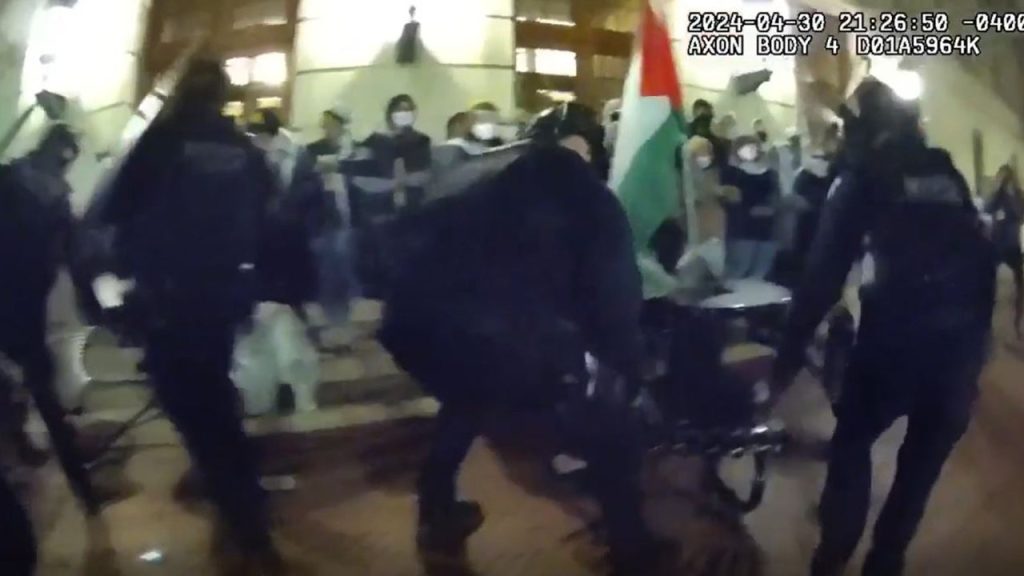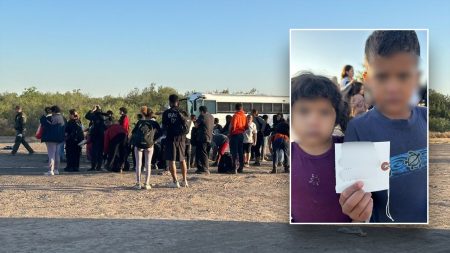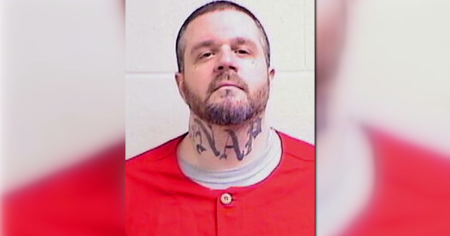The video captured from New York City police officers’ body-worn cameras shows authorities breaking into a Columbia University building that had been seized by anti-Israel protesters. The officers, wearing protective gear, breached Hamilton Hall where the protesters had barricaded themselves inside. Many of the protesters were not students at the university, but rather outside agitators, according to NYPD Deputy Commissioner of Public Information Tarik Sheppard. These individuals are professionals who may travel from place to place with external funding, Sheppard explained. It is easy for passionate and upset students to be influenced by these professionals to take over buildings or engage in disruptive behavior.
The bodycam footage reveals officers using a tool to open a front door that had been barricaded with multiple chairs stacked from the inside. Inside, they encountered a barrier made of furniture that required cutting through with a saw. Protesters from the outside were heard chanting “Free, free Palestine!” as officers worked to gain access. An officer can be heard suggesting the deployment of a flashbang grenade, followed by loud bangs. After breaking through the barrier, officers reached protesters sitting in a room where they were detained. The intervention was only permitted once the university officially requested help. At least through the middle of May, several universities in the city have requested NYPD presence on their campuses to ensure peace and security.
Sheppard emphasized the importance of universities developing a plan to self-sustain and maintain security without the continuous support of law enforcement. The goal is to prevent campuses from returning to a state of unrest and chaos. The involvement of professional agitators in influencing young minds to engage in disruptive actions is concerning, as students may be easily persuaded when they are passionate about certain issues. The bodycam footage provides an insight into the challenges faced by law enforcement in dealing with protests that have the potential to escalate into unlawful activities. The use of force, such as the deployment of flashbang grenades, is a necessary measure in some situations to ensure the safety of both protesters and officers.
The incident at Columbia University highlights the complex dynamics involved in dealing with protests and demonstrations on college campuses. The presence of outside agitators who are well-funded and experienced in manipulation poses a significant challenge to maintaining order and preventing disruptions. The collaboration between law enforcement agencies and university administrations is crucial in addressing these issues and ensuring the safety of students, faculty, and staff. It is essential for universities to have a proactive approach in handling potential protests and developing strategies to prevent unauthorized takeovers of buildings or other disruptive behaviors. By working together, law enforcement and university officials can effectively address security concerns and maintain a peaceful environment on campus.
The bodycam video serves as a valuable tool in documenting the events that unfolded during the intervention at Columbia University. It provides a firsthand account of the actions taken by law enforcement officers and the responses of protesters during the incident. The footage offers transparency and accountability in evaluating the conduct of both parties involved and can be used as evidence in any subsequent investigations or legal proceedings. The use of technology, such as body-worn cameras, has become an essential component in modern policing practices, enabling law enforcement agencies to capture real-time footage of interactions with the public and ensure accountability in their actions. The video from the Columbia University incident sheds light on the challenges faced by law enforcement in maintaining public order during protests and the importance of effective communication and collaboration between all stakeholders to address security concerns in a proactive and coordinated manner.
In conclusion, the incident at Columbia University underscores the need for universities and law enforcement to work together in addressing protests and demonstrations on campus effectively. The presence of outside agitators and professional manipulators adds a layer of complexity to these situations, requiring a strategic and coordinated response to maintain order and safety. The bodycam footage provides a firsthand account of the intervention at Columbia University, highlighting the challenges faced by law enforcement officers and the importance of transparency in evaluating their actions. By developing proactive plans and strategies to address potential disruptions, universities can minimize the risk of unauthorized takeovers and maintain a safe environment for all members of the campus community.















